Is Hiking In Crocs A Thing? We Did a Survey Over 200 Hikers
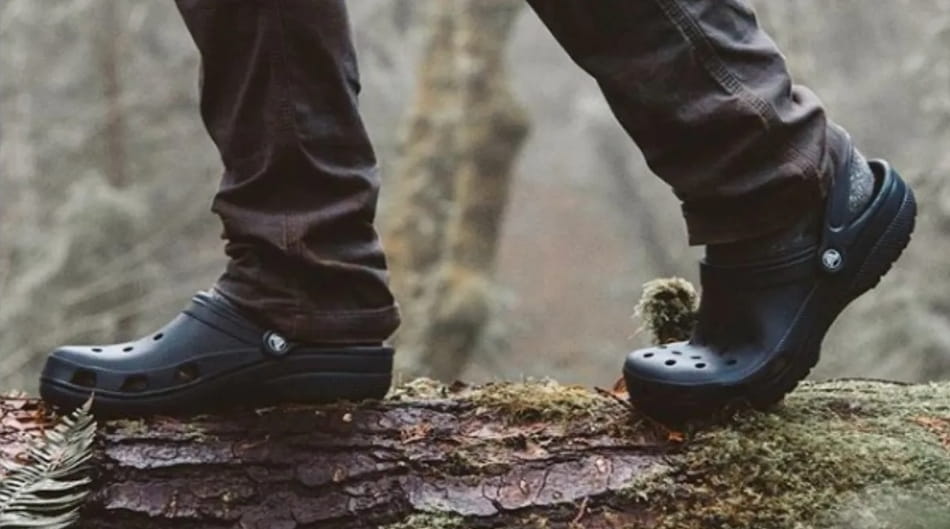
If you’re a hiker, the idea of hiking in Crocs might have crossed your mind. These popular clog-style shoes are known for their comfort and breathability, but are they suitable for the trails? Let’s talk about the advantages and disadvantages of using Crocs for hiking. So, let’s start!
Are Crocs Good For Hiking? Crocs can be good and comfortable for hiking if you like wearing them daily. They’re flexible, soft, and loose-fitting. Crocs might be great for short distances, but they can quickly become uncomfortable for longer distances (of over 5 miles).
Hiking in Crocs sparks varied reactions among hikers. Many think it’s a bad choice, while some genuinely like it. It all comes down to personal preference. After asking a lot of hikers and performing a detailed review by many hikers, I’ve grasped why some praise hiking in Crocs and why others don’t favor it.
Table of Contents
Is Hiking in Crocs Possible?
Technically, you can hike in almost any shoe that exists, while on the other hand, you don’t even need shoes. While this is not recommended, some folks do opt to hike in Crocs. But there is a reason why it is so.
Choosing just any shoe doesn’t always guarantee a pleasant journey. Some can increase the risk of blisters, ankle twists, or even more severe injuries. That’s why many avid hikers vouch for durable hiking boots that offer ample support and cushioning for a secure and comfy trek.
We Asked Over 200 Hikers To See How Many Of Them Use Crocs
Curious about the popularity of hiking in Crocs, I asked over 200 hikers how many preferred them for their treks. The results were quite unexpected. Here is what I asked.
Pool Question: What footwear is your favorite to use when hiking more than 5+ miles?
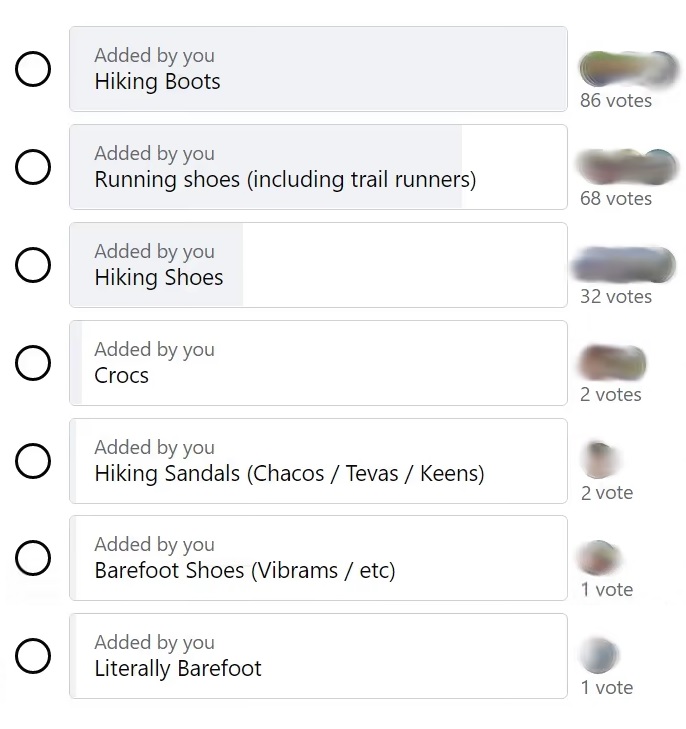
By using this data, we learned that only 1.15% of participants prefer Crocs for long hikes. This percentage is on par with those who wear minimalist shoes or even hike completely barefoot. Clearly, trail-goers in Crocs are a rare breed.
Nearly half (around 47%) of the hikers we asked chose hiking boots. About 38% go for running or trail running shoes when hiking, and roughly 14% prefer hiking shoes. I’m also in the part of that 14% – I pick hiking shoes because they are very similar to boots but sport a shorter cut.
Related Article: Are Military Boots Good For Backpacking?
Are Crocs Suitable as Water Shoes?
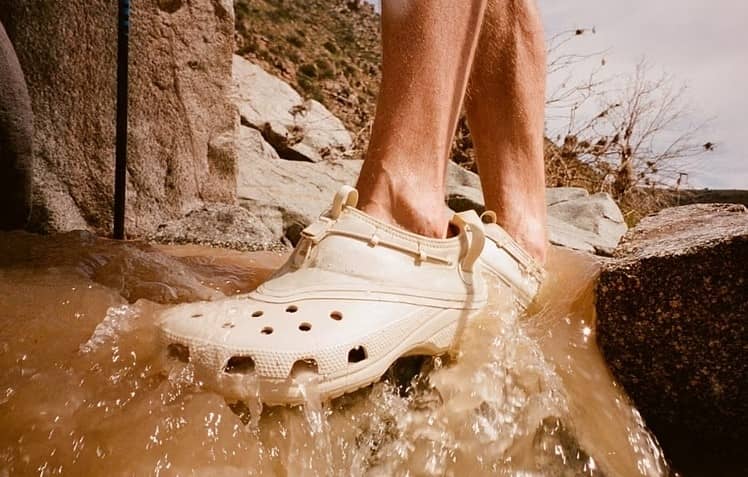
When appropriately fitted, Crocs can also serve as water shoes. However, they might not always be the best choice. Depending on the water activity, you might want shoes that offer a tighter grip or better foot protection.
It’s also worth noting that while Crocs can handle getting wet, they might not provide the same level of traction or protection as specialized water shoes. Always consider your specific needs and the nature of the water activity before choosing.
Why Opt For Crocs on a Hiking Trip?
When hiking, some people like exploring different types of footwear choices on trails to discover their fit. Crocs, for instance, have their share of passionate advocates across various hiking terrains.
While hiking in Crocs is possible, it’s worth a shot to see if they align with your comfort level. If you’re someone who finds Crocs comfy for day-to-day use, consider taking them for a spin on a short, light hike. Packing an extra pair of shoes is a good idea if the Croc experience isn’t what you hoped for.
But you might end up liking the experience of hiking in Crocs. If that’s the case, you can venture on extended treks. Just ensure you have a first aid kit and an alternate comfy pair of shoes until you’re certain that Crocs truly resonate with your hiking style.
At the very least, Crocs can serve as excellent backup footwear on hikes, especially useful for crossing streams, ensuring you don’t have to go barefoot or drench your primary boots.
If you want to see what it looks like to hike in a Crocs, listen to what she has to say:
The Pros Of Hiking In Crocs
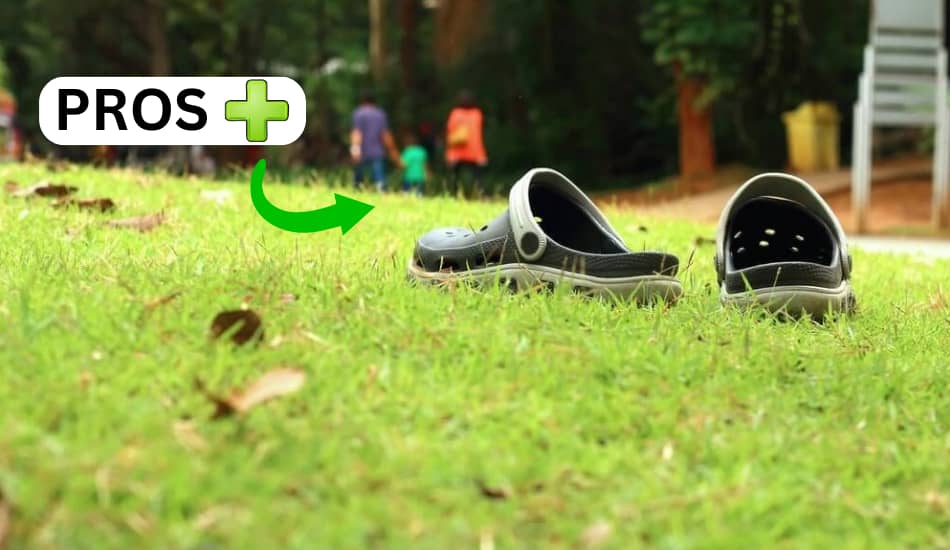
Hiking in Crocs comes with its set of advantages. They are notably comfortable, apt for damp environments, and aid in keeping feet moisture-free. Due to these pros, some trail enthusiasts highly recommend them. Here are some of the pros of using Crocs on your hiking trips.
They Are Cheap
High-quality hiking shoes often come with a high price tag. Not everyone is willing or able to pay out over $100 for hiking gear, particularly when there’s uncertainty about its longevity. Also, Crocs offers significant comfort at a fraction of the price, although the exact cost depends on the model. Some rugged Crocs variants can cost more than $50, comparable to certain hiking footwear.
While some hikers might lean towards budget-friendly hiking shoes, an ill-fitting pair can lead to painful blisters. Based on diverse hiker feedback, Crocs seem to reduce the risk of blisters, except perhaps in sandy terrains. A pro tip from some Croc enthusiasts is to pair them with socks, minimizing friction that can induce blisters.
Comfort Level
While Crocs might not be the prettiest shoes you’ve ever seen, their comfort is undeniable. As pointed out by WebMD, Crocs are crafted keeping in mind those who find regular footwear uncomfortable. They offer good ankle support. While some praise this feature, others think it could weaken ankles over prolonged use.
Nonetheless, many who slip into Crocs often describe the feeling akin to sporting a robust set of house slippers. This coziness is why they’re a favorite for home use, camping, or quick outside trips.
Crocs Dry Quickly
Embarking on a path with numerous water encounters? Crocs could be the perfect thing for you. Unlike typical hiking footwear, Crocs ensure your feet quickly dry post-water adventures. No more fretting over damp socks or odorous, water-logged shoes. Plus, if you want to take a swim, Crocs protect your feet from potential injuries like jagged stones or shards.
Breathable
Thanks to their design, many Croc models offer superior breathability. This is a boon for those whose feet tend to perspire. Cooler feet contribute significantly to overall comfort, especially during hikes in warmer climates. Moreover, drier feet are less susceptible to those bothersome hiking blisters.
Damp socks over extended treks can be a primary reason for blisters. The significance of maintaining dry feet cannot be overstated. Regardless of whether you’re wearing Crocs or traditional hiking boots, blisters, especially on the heels, can mar your hiking joy.
Diverse Styles
While the iconic clog-style Croc is what usually comes to our mind, the brand offers many other designs. This includes sandals tailored for water traversing, work-specific Crocs, and even slip-on versions. If you’re contemplating footwear suitable for hiking, explore these diverse styles. You might discover a design that’s a match made in hiking heaven. It’s undoubtedly worth a peek.
Related Article: Are Duck Boots Good for Hiking?
The Cons Of Hiking In Crocs
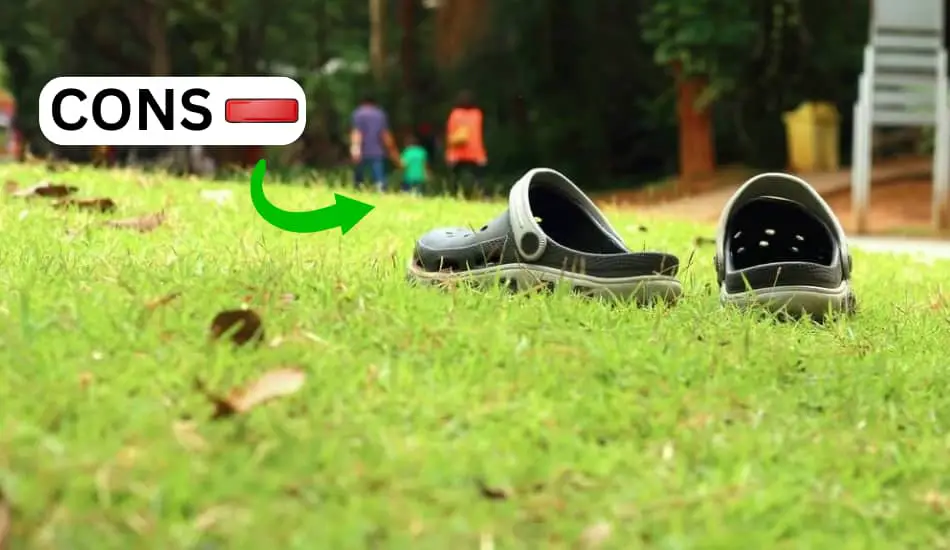
Finding the ideal hiking footwear is often a challenge. What one hiker praises, another might find wholly unsatisfactory. The choice largely varies from person to person. While some might deem Crocs as the ultimate hiking companion, others point out certain shortcomings. Here are potential issues you could encounter hiking in Crocs:
Crocs Don’t Have Strong Grip
Although Crocs can quickly dry after you step into a river or water, certain Croc models can be slick when wet. If waterlogged paths are a consistent part of your trail, standard Crocs might not be the best choice.
However, Crocs offers other designs, like the Swiftwater, tailored to be more aqua-adaptable. While there’s no absolute assurance against slipping, you might stumble upon a Croc model that aligns with your needs.
Insufficient Sole Protection
Another disadvantage of these shoes is their thin soles. Standard Crocs are not tailored for rugged trails. While they might be apt for a casual stroll in the neighborhood, trekking on rocky terrain could be painful as you’d likely feel every stone.
For individuals who are used to wearing comfortable sneakers when hiking, their feet might not be resilient enough for such challenges. And I cannot stress this enough: I’ve hiked in all types of shoes with thinner soles, and the pressure from continuous treading on rocky paths is rather pronounced. A sturdy sole is invaluable in ensuring foot comfort.
To get over it, some may choose to build resilience in their feet rather than invest in padded hiking shoes, aiming to be less bothered by ground debris.
Crocs Have Holes
Although crocs are recognizable by having holes all over, they sometimes represent a drawback. These holes become entry points for little nuisances such as rocks, bugs, insects, and sand. As a result, you might find yourself pausing your hike frequently to rid your shoes of these unwelcome intruders. Even more concerning, these foreign objects can sometimes pose a threat to your foot’s safety.
Slippery Feet
In addition to the potential limited traction on the base of Crocs, a common issue is the foot sliding inside, especially when wet. This slippage can increase the risk of a twisted ankle or a misstep, whether it’s due to perspiration or traipsing through water.
This becomes particularly risky if you find yourself needing to dash momentarily, say, while chasing after a playful toddler. Such movements and foot slippage can easily create enough friction to induce blisters.
Those hikers who love Crocs often suggest integrating accessories like insoles or even wearing socks. However, if these additions get wet, you’ll likely switch them out often. On the bright side, insoles might also offer some buffer against sharp terrains. And let’s face it, wet socks are a discomfort regardless of the shoe, so that aspect isn’t unique to Crocs.
If you want to learn more about the pros and cons of wearing a Crocs, here is one interesting video you should watch:
Final Thoughts
Crocs offers a unique blend of comfort and quick-drying capabilities, ideal for certain terrains and water crossings. However, their general design may lack the grip and support needed for more challenging trails. The potential for foot slippage inside the shoe, especially when wet, can be a concern.
While some dedicated models like the Offroad Crocs aim to bridge these gaps, traditional hiking shoes often provide more comprehensive protection and support. While Crocs can be suitable for light hikes and specific conditions, they might not be the best choice for rigorous trekking.

